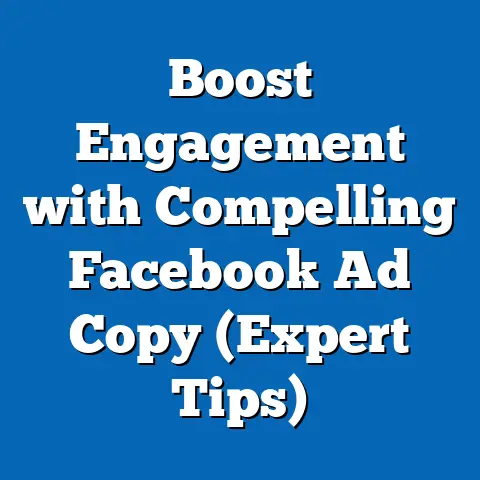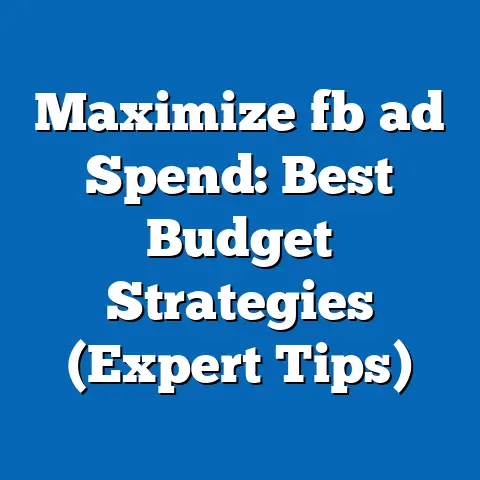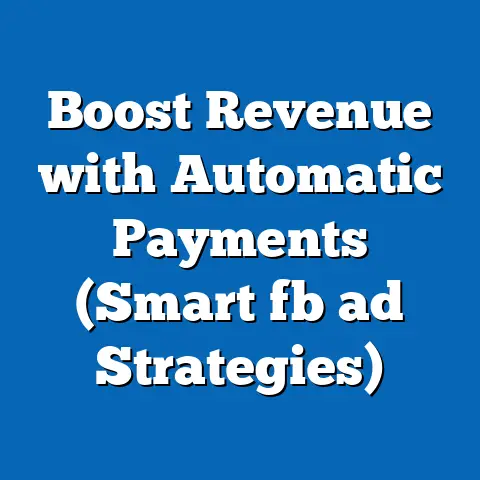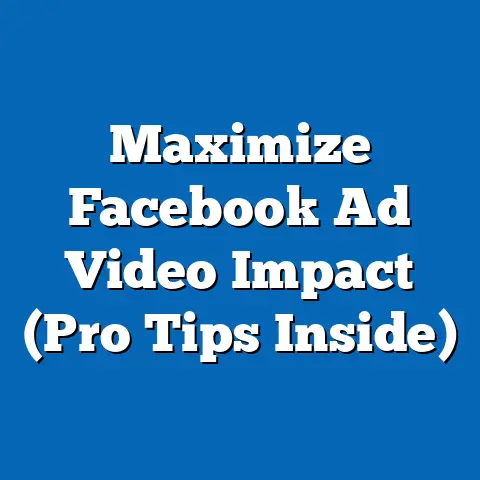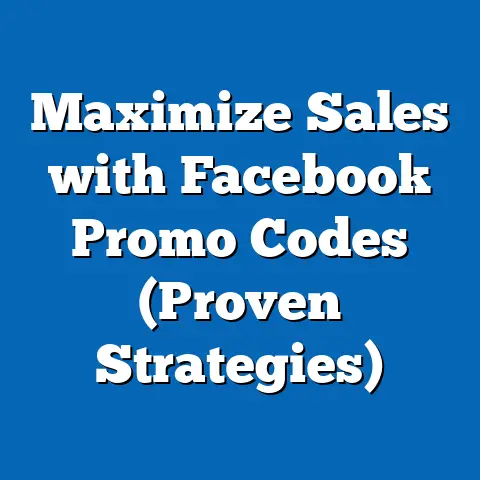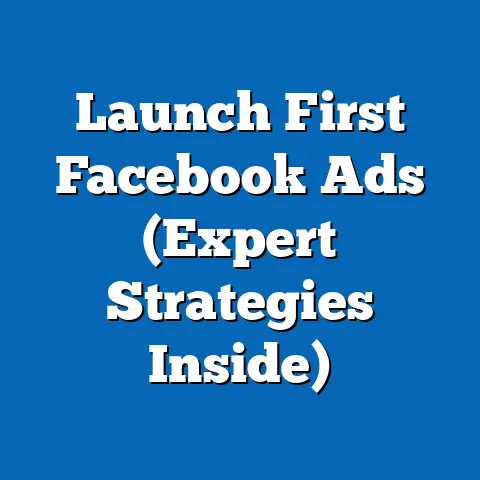Maximize Facebook Ad Size (Essential Dimensions Explained)
In an age where every click matters and every impression counts, optimizing your digital marketing strategy is more critical than ever. Just like energy savings in our homes can lead to significant reductions in bills, maximizing the size and effectiveness of your Facebook ads can lead to impressive returns on your advertising investment. The dimensions of your ads are not merely numbers; they are essential elements that influence visibility, engagement, and ultimately, conversion rates. I’ve seen firsthand how a simple tweak in ad dimensions can drastically improve performance. This article delves into the essential dimensions of Facebook ads, ensuring you understand how to leverage them for maximum impact.
Understanding Facebook Ad Formats
To truly master Facebook advertising, it’s vital to understand the different ad formats available and how to best utilize each one. It’s not a one-size-fits-all approach; each format has its own strengths and weaknesses.
Overview of Facebook Ad Types
Facebook offers a diverse range of ad formats, each designed to cater to different marketing needs and objectives. Here’s a brief overview:
- Image Ads: Simple and effective, these ads use a single image and accompanying text to convey your message. They’re great for showcasing products or promoting events.
- Video Ads: Engaging and dynamic, video ads capture attention more effectively than static images. They’re ideal for telling stories, demonstrating product features, or sharing testimonials.
- Carousel Ads: These ads allow you to display multiple images or videos within a single ad unit. They’re perfect for showcasing a range of products, highlighting different features of a single product, or telling a sequential story.
- Slideshow Ads: Similar to video ads, slideshow ads combine multiple images or videos into a visually appealing presentation. They’re a cost-effective alternative to video ads, especially for businesses with limited resources.
- Collection Ads: Designed for e-commerce businesses, collection ads feature a main video or image along with several product images. They’re great for showcasing a curated collection of products and driving sales.
Each of these formats serves a different purpose, and understanding their nuances is crucial for creating effective campaigns. For example, I once worked with a clothing retailer who was struggling to showcase their entire product line. By switching from single image ads to carousel ads, they were able to display multiple items and saw a significant increase in click-through rates.
Importance of Ad Dimensions
Ad dimensions play a crucial role in user experience and engagement. Think of it like this: would you rather read a book with a clear, well-formatted layout or one with tiny, cramped text? The same principle applies to Facebook ads.
- User Experience: Correct ad dimensions ensure that your ads are displayed properly across different devices and platforms. This creates a seamless and enjoyable experience for users, increasing the likelihood of engagement.
- Engagement: Ads with optimal dimensions are more visually appealing and grab attention more effectively. This leads to higher click-through rates, more shares, and ultimately, better results.
Incorrect dimensions can have serious implications:
- Poor Visibility: Ads that are cropped, stretched, or distorted due to incorrect dimensions can look unprofessional and unappealing. This can lead to users scrolling past your ad without giving it a second glance.
- Reduced Click-Through Rates: If your ad looks sloppy or unprofessional, users are less likely to click on it. This can result in wasted ad spend and missed opportunities.
Takeaway: Understanding the different ad formats and their ideal dimensions is the first step towards creating effective Facebook advertising campaigns. The right dimensions can make a huge difference in user engagement and overall performance.
Essential Dimensions for Facebook Ad Formats
Now, let’s dive into the specifics. Knowing the recommended dimensions for each ad format is crucial for ensuring your ads look their best and perform optimally.
Image Ads
Single image ads are a staple of Facebook advertising, and getting the dimensions right is key to making a strong visual impact.
- Recommended Image Size: 1200 x 628 pixels
- Aspect Ratio: 1.91:1
- File Formats: JPG or PNG
It’s important to maintain high image resolution to avoid pixelation or blurriness. A crisp, clear image will always perform better than a low-quality one. I once had a client who insisted on using low-resolution images in their ads to save on file size. The result was a significant drop in engagement and click-through rates. Once we switched to high-resolution images, their performance improved dramatically.
Best Practices:
- Use High-Resolution Images: Ensure your images are sharp and clear, even on high-resolution displays.
- Keep Text to a Minimum: Facebook recommends limiting text to 20% of the image area. Too much text can reduce your ad’s reach.
- Choose Visually Appealing Images: Select images that are relevant to your target audience and that capture their attention.
Example: A successful image ad might feature a vibrant, high-quality photo of a product in use, accompanied by a concise and compelling headline.
Video Ads
Video ads are incredibly powerful for capturing attention and conveying your message in a dynamic and engaging way.
- Recommended Dimensions: 1280 x 720 pixels (720p) or higher
- Aspect Ratios:
- Horizontal (16:9)
- Square (1:1)
- Vertical (9:16)
- File Formats: MP4 or MOV
- Horizontal (16:9)
- Square (1:1)
- Vertical (9:16)
The length and format of your video can significantly impact viewer engagement. Shorter videos tend to perform better, especially on mobile devices. I’ve found that videos under 15 seconds are ideal for capturing attention and driving quick actions.
Best Practices:
- Use Captions: Many users watch videos with the sound off, so captions are essential for conveying your message.
- Optimize Thumbnails: Choose a compelling thumbnail that accurately represents your video and entices users to click.
- Keep it Concise: Get to the point quickly and maintain a fast pace to keep viewers engaged.
Example: A compelling video ad might feature a short, attention-grabbing clip showcasing a product’s key benefits, accompanied by clear and concise text overlays.
Carousel Ads
Carousel ads offer a unique opportunity to showcase multiple products or tell a sequential story within a single ad unit.
- Recommended Image Size: 1080 x 1080 pixels
- Aspect Ratio: 1:1 (Square)
- File Formats: JPG or PNG
Each image or video in your carousel should be visually consistent and contribute to the overall message. Think of it as a mini-storyboard, guiding users through a narrative or showcasing a range of options.
Best Practices:
- Tell a Story: Use each card in the carousel to tell a different part of a story or highlight a different feature of your product.
- Use High-Quality Images: Ensure all images are sharp, clear, and visually appealing.
- Include a Clear Call to Action: Encourage users to click through to your website or take a specific action.
Example: A successful carousel ad might feature a series of images showcasing different outfits from a clothing retailer, each with a link to purchase the featured items.
Slideshow Ads
Slideshow ads are a cost-effective alternative to video ads, allowing you to create visually appealing presentations using a series of images or videos.
- Recommended Image Size: 1280 x 720 pixels
- Aspect Ratio: 16:9 (Horizontal) or 1:1 (Square)
- File Formats: JPG or PNG
Slideshow ads are great for storytelling, showcasing product features, or creating engaging tutorials. They’re also a good option for businesses with limited video production resources.
Best Practices:
- Use High-Quality Images: Ensure all images are visually appealing and relevant to your target audience.
- Add Music or Voiceover: Enhance the slideshow experience with background music or a voiceover narration.
- Keep it Short and Sweet: Aim for a slideshow length of 15-30 seconds to maintain viewer engagement.
Example: A compelling slideshow ad might feature a series of images showcasing a travel destination, accompanied by upbeat music and text overlays highlighting key attractions.
Collection Ads
Collection ads are designed for e-commerce businesses, allowing you to showcase a curated collection of products in a visually appealing format.
- Recommended Image Size: 1200 x 628 pixels (Main Image)
- Recommended Image Size: 600 x 600 pixels (Product Images)
- Aspect Ratio: 1.91:1 (Main Image)
- Aspect Ratio: 1:1 (Product Images)
- File Formats: JPG or PNG
Collection ads typically feature a main image or video along with several product images, allowing users to browse a selection of items directly from the ad.
Best Practices:
- Use High-Quality Images: Ensure all images are visually appealing and accurately represent your products.
- Curate Your Collection: Select products that are relevant to your target audience and that complement each other.
- Optimize for Mobile: Collection ads are designed for mobile devices, so ensure they look great on smaller screens.
Example: A successful collection ad might feature a main video showcasing a new product line, along with several product images linking directly to the corresponding product pages on the retailer’s website.
Takeaway: Each ad format has its own unique dimension requirements, and adhering to these guidelines is crucial for creating visually appealing and effective ads. By using high-quality images, optimizing for mobile, and telling compelling stories, you can maximize the impact of your Facebook advertising campaigns.
Best Practices for Ad Dimensions
Beyond simply knowing the recommended dimensions, there are several best practices to keep in mind to ensure your ads are as effective as possible.
Creating for Mobile
In today’s mobile-first world, optimizing your ads for mobile devices is absolutely essential. According to Statista, mobile devices account for a significant portion of Facebook’s ad revenue, so it’s crucial to cater to this audience.
- Mobile Optimization: Ensure your ads are visually appealing and easy to interact with on smaller screens.
- Vertical Video: Consider using vertical video for mobile ads, as it takes up more screen real estate and captures attention more effectively.
- Fast Loading Times: Optimize your images and videos for fast loading times, as mobile users are often on slower connections.
I’ve seen countless campaigns where the desktop version looks fantastic, but the mobile experience is subpar. This is a huge missed opportunity, as mobile users are often more engaged and more likely to convert.
A/B Testing with Dimensions
A/B testing is a powerful tool for optimizing your ad dimensions and finding the most effective layout for your target audience.
- Set Up A/B Tests: Use Facebook Ad Manager to create multiple versions of your ad with different dimensions.
- Track Performance: Monitor key metrics such as click-through rates, conversion rates, and cost per acquisition to determine which dimensions perform best.
- Iterate and Optimize: Continuously test different dimensions and layouts to refine your ads and improve their performance.
Step-by-Step Guide to A/B Testing:
- Create Two Ad Sets: Duplicate your existing ad set and make changes to the dimensions of the ads in the new ad set.
- Set a Budget: Allocate a budget for each ad set, ensuring they have enough spend to generate meaningful data.
- Run the Test: Allow the test to run for a sufficient period of time (e.g., one week) to gather enough data.
- Analyze the Results: Use Facebook Ad Manager to compare the performance of the two ad sets and identify the winning dimensions.
- Implement the Changes: Apply the winning dimensions to your other ad campaigns to improve their performance.
Adjusting Ad Dimensions for Different Audiences
Different audiences may respond differently to various ad sizes and layouts. Tailoring your ad dimensions based on audience demographics and device usage can significantly improve your results.
- Demographics: Consider the age, gender, and interests of your target audience when selecting ad dimensions.
- Device Usage: Analyze the device usage of your target audience (e.g., mobile vs. desktop) and optimize your ads accordingly.
- Experimentation: Don’t be afraid to experiment with different dimensions and layouts to see what resonates best with your target audience.
For example, I once worked with a client who was targeting both millennials and baby boomers. We found that millennials responded better to vertical video ads on mobile devices, while baby boomers preferred horizontal image ads on desktop computers. By tailoring our ad dimensions to each audience, we were able to significantly improve our overall campaign performance.
Takeaway: Optimizing your ad dimensions for mobile, conducting A/B tests, and tailoring your ads to different audiences are all essential best practices for maximizing the impact of your Facebook advertising campaigns.
Tools and Resources for Dimension Optimization
Creating ads with the correct dimensions doesn’t have to be a headache. There are plenty of tools and resources available to make the process easier and more efficient.
Design Tools
Several design tools can help you create ads with the correct dimensions, even if you’re not a professional designer.
- Canva: A user-friendly design tool with pre-set templates for Facebook ads. Canva makes it easy to create visually appealing ads with the correct dimensions, even if you have no design experience.
- Adobe Spark: A powerful design tool that offers a range of features for creating stunning Facebook ads. Adobe Spark is a great option for businesses that want to create high-quality ads with a professional look and feel.
- PicMonkey: A versatile design tool that allows you to create and edit images for Facebook ads. PicMonkey offers a range of features for resizing, cropping, and enhancing your images, ensuring they look their best in your ads.
These tools often include features that simplify the ad creation process, such as drag-and-drop interfaces, pre-designed templates, and automated resizing options.
Facebook Ad Manager
Facebook Ad Manager is your go-to tool for creating, managing, and analyzing your Facebook advertising campaigns.
- Dimension Check: Use Facebook Ad Manager to check and adjust ad dimensions before launching your campaign.
- Reporting Features: Track performance by ad size to identify which dimensions are most effective.
- Ad Preview: Preview your ads on different devices to ensure they look great on both mobile and desktop.
Facebook Ad Manager also provides valuable reporting features that allow you to track the performance of your ads by size, helping you identify which dimensions are most effective for your target audience.
Resources for Staying Updated
Facebook’s ad guidelines are constantly evolving, so it’s crucial to stay up-to-date with the latest changes.
- Facebook Business Help Center: A comprehensive resource for all things Facebook advertising, including ad specifications, best practices, and troubleshooting tips.
- Facebook Marketing Partners: A network of trusted experts who can provide guidance and support for your Facebook advertising campaigns.
- Industry Blogs and Publications: Stay informed about the latest trends and best practices in Facebook advertising by following industry blogs and publications.
I make it a habit to check the Facebook Business Help Center regularly to stay informed about any changes to ad specifications or guidelines. It’s a small investment of time that can save you a lot of headaches down the road.
Takeaway: By leveraging the right design tools, utilizing Facebook Ad Manager effectively, and staying up-to-date with the latest guidelines, you can streamline the ad creation process and ensure your ads are always optimized for success.
Conclusion: The Path to Effective Facebook Advertising
In conclusion, understanding and maximizing Facebook ad sizes is essential for any marketer looking to enhance their digital marketing efforts. Just as energy savings can lead to a more sustainable and cost-effective home, optimized Facebook ads can yield better engagement and higher conversion rates. By leveraging the proper dimensions and adhering to best practices, marketers can create compelling ads that resonate with their target audience and drive desired results.
Remember, the key takeaways are:
- Know Your Formats: Each Facebook ad format has specific dimension requirements. Understand them and adhere to them.
- Mobile-First: Always optimize your ads for mobile viewing.
- Test and Iterate: Use A/B testing to find the dimensions that work best for your audience.
- Stay Updated: Facebook’s ad policies and dimensions change frequently, so stay informed.
As you embark on your Facebook advertising journey, remember that the dimensions of your ads are not just numbers; they are the foundation of your digital marketing success. By paying attention to these details, you can create ads that not only look great but also deliver real results. Now go out there and create some amazing, perfectly-sized Facebook ads!

